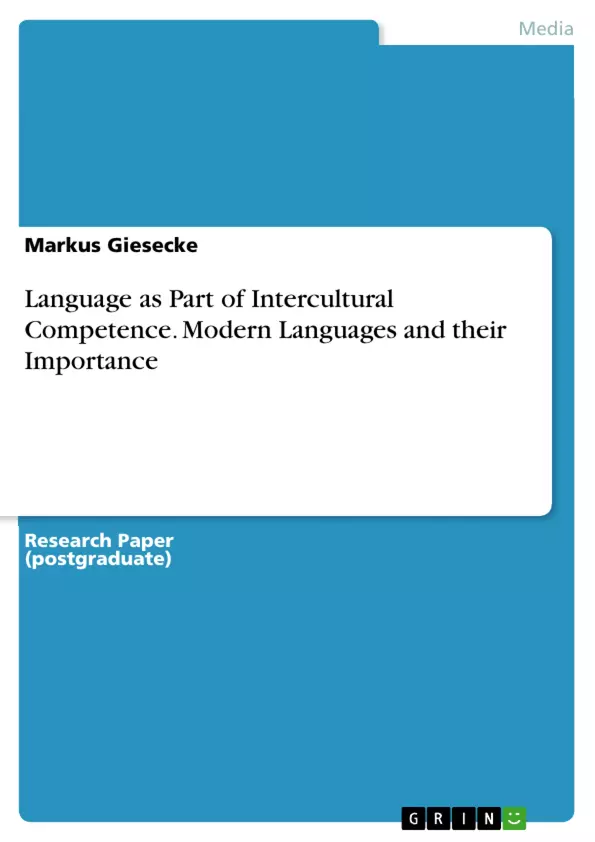Language, or communication, in a broader sense, is just a part of culture but a very important one because a shared language allows members of different cultures to express themselves and communicate with each other. Just as norms, expectations and behaviour, language vary across cultures, and it can change and evolve in the course of time for several reasons, e.g. new needs of the speakers of a language, technological progress, new products, just to mention a few.
The origins of human language have been discussed as a topic for centuries and there is no consensus as to when it really began. Noam Chomsky, an American linguist and often referred to as the "father of modern linguistics", states that it has been an evolutionary process that still goes on today because he speaks of a so-called Language Faculty as a special component of the human brain which is specifically dedicated to language and required for language acquisition.
Michael Corballis, emeritus professor at the Department of Psychology at the University of Auckland, is challenging Chomsky's theory as he argues in his book "The Truth about Language" that gesture was crucial to the development of speech instead of a single mutation in a single human. He states that we share that ability with other animals and his idea is supported by investigations of sign languages developed by deaf children who start to babble with their hands just as hearing children do with their mouths.
Languages are constantly changing and this makes it difficult to count the exact number of living languages existing in the world today. Another problem could be the definition of a language because there is a difference between a language and a dialect, or between a language and a macrolanguage. For that reason, the International Organization for Standardization (ISO) has set international standards toward comprehensive coverage of languages and language groups in the ISO 639 series. The language codes are used in the Ethnologue, a catalog of living languages published by SIL International, which is the registration authority for ISO 639-3. According to Ethnologue (19th edition), there are 7,097 living languages in the world.
Inhaltsverzeichnis (Table of Contents)
- INTRODUCTION
- ORIGINS OF LANGUAGE
- MODERN LANGUAGES AND THEIR IMPORTANCE
- LANGUAGE STATUS AND EGIDS SCALE
- ENGLISH
- GERMAN
- MODERN STANDARD ARABIC
- BASQUE
- ESPERANTO
- LANGUAGE MISTAKES IN MARKETING
- NON-VERBAL COMMUNICATION
Zielsetzung und Themenschwerpunkte (Objectives and Key Themes)
This research paper examines the role of language in intercultural competence. It aims to explore the origins of language, the importance of modern languages in a globalized world, and the impact of language status and the EGIDS scale on intercultural communication. The paper also delves into the significance of language in marketing and the role of nonverbal communication in intercultural settings.
- The origins and development of language
- The importance of modern languages in a globalized world
- The relationship between language status and intercultural competence
- The impact of language mistakes in marketing
- The role of nonverbal communication in intercultural settings
Zusammenfassung der Kapitel (Chapter Summaries)
- INTRODUCTION: This chapter sets the stage for the research paper, outlining the objectives and scope of the study. It introduces the concept of intercultural competence and the importance of language in achieving it.
- ORIGINS OF LANGUAGE: This chapter delves into the origins and development of language, exploring various theories and perspectives. It examines the historical evolution of language and its impact on human communication.
- MODERN LANGUAGES AND THEIR IMPORTANCE: This chapter explores the significance of modern languages in a globalized world, highlighting their role in communication, commerce, and diplomacy. It examines the impact of globalization on language use and the emergence of new languages and dialects.
- LANGUAGE STATUS AND EGIDS SCALE: This chapter discusses the concept of language status and its impact on intercultural communication. It introduces the Expanded Graded Intergenerational Disruption Scale (EGIDS) and analyzes the status of various languages, including English, German, Modern Standard Arabic, Basque, and Esperanto, in the context of the EGIDS scale.
- LANGUAGE MISTAKES IN MARKETING: This chapter explores the consequences of language mistakes in marketing, highlighting the importance of accurate and culturally appropriate language use in international campaigns. It examines various examples of language blunders and their impact on brand perception.
- NON-VERBAL COMMUNICATION: This chapter focuses on the role of nonverbal communication in intercultural settings. It examines various forms of nonverbal communication, such as body language, gestures, and facial expressions, and their importance in conveying meaning and establishing rapport across cultures.
Schlüsselwörter (Keywords)
This research paper focuses on the key concepts of language, intercultural competence, language status, EGIDS scale, language mistakes in marketing, and nonverbal communication. It explores the interrelationship between these concepts and their impact on communication, business, and globalization.
- Citation du texte
- Markus Giesecke (Auteur), 2016, Language as Part of Intercultural Competence. Modern Languages and their Importance, Munich, GRIN Verlag, https://www.grin.com/document/358199



